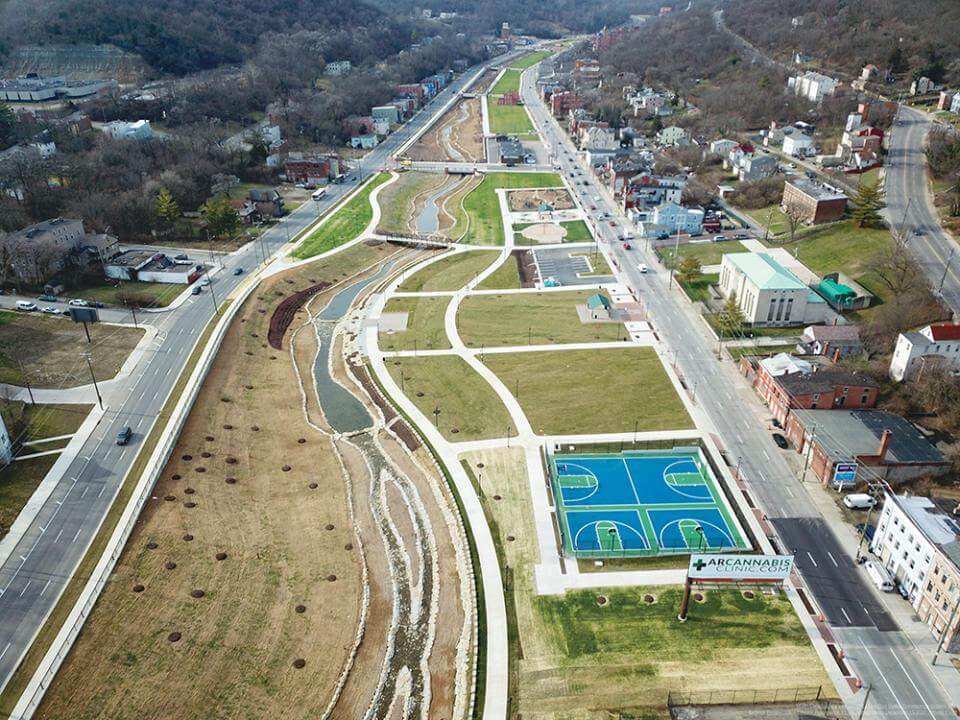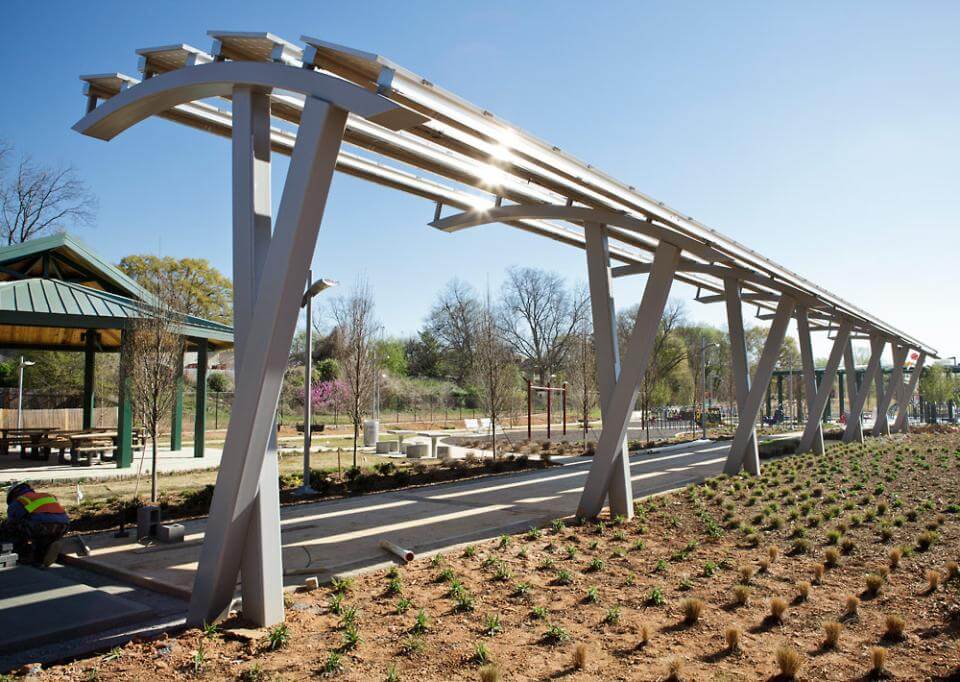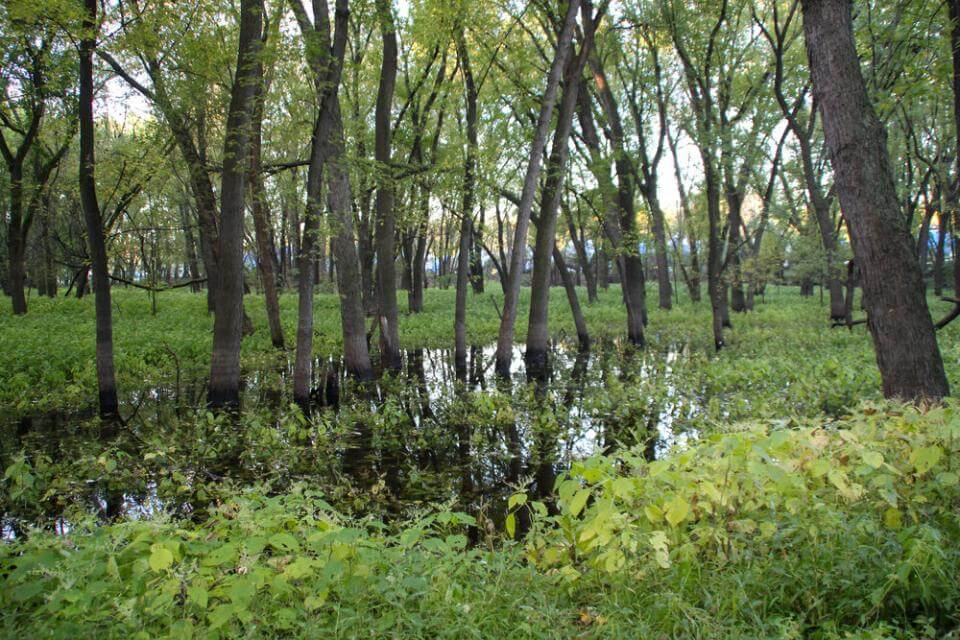One-third of Americans, including 28 million children, lack safe, easy access to a park within a 10-minute walk of home. Urge your senators to allocate funding to create parks and enhance outdoor recreational opportunities by championing the Outdoors for All Act today!
As we revealed in our special report, “The Power of Parks to Address Climate Change,” cities and towns across the country already have tools and resources to protect residents—especially those who are most at risk—from the effects of a warming climate. What are they? Parks, green space, trails, and schoolyards. As part of our 2022 ParkScore® index, we surveyed parks departments to learn about what they’re doing to combat flooding, manage stormwater, reduce urban heat, mitigate wildfire danger, and reduce or capture atmospheric carbon. The projects below—some large and complex, others relatively simple—stood out among the responses. These innovative examples highlight the impact nature-investments in nature-based solutions can have on local communities. Kudos to these cities and their partners for leaning into this critical work.
Denver’s Cherry Creek Stream Restoration Expands Regional Trails
The Cherry Creek Restoration Project is a collaboration among the Mile High Flood District, the City and County of Denver, Arapahoe County, the Southeast Metro Stormwater Authority, and Denver Water to restore a 1-mile stretch of the Cherry Creek corridor between South Quebec Street and East Iliff Avenue. The stream was experiencing severe erosion, resulting in 10- to 20-foot deep vertical banks, degraded vegetation, and risk for significant damage to the trail and adjacent roadway. This corridor restoration will provide a range of benefits: open space for passive and active recreation, better connectivity to regional walking and biking trails, cooling tree canopy, enhanced wildlife habitat, improved water quality, and a stable stream to protect people and property from flood hazards.
According to TPL Climate Director Brendan Shane, restoration projects like this are especially impactful because they address multiple climate threats while delivering numerous community benefits. “The Cherry Creek project really looked at the big picture, leveraging public investment to manage and clean water, reduce urban heat, support wildlife, and connect people to the outdoors,” he says.
Cincinnati’s Lick Run Greenway Reduces Pollution and Creates Neighborhood Parks
“Lick Run Greenway demonstrates the superpowers of parks,” says TPL Climate Director Brendan Shane. “The project delivers major environmental benefits to manage increasingly intense storms but goes so much further to revitalize, connect, and serve the surrounding community.” A major investment to reduce sewer overflows and control stormwater funded creation of this 1.5-mile long greenway in Cincinnati’s South Fairmount neighborhood. The centerpiece of the Metropolitan Sewer District’s project was “daylighting” the stream, which was buried 130 years ago in a sewer tunnel. With input from the South Fairmount Community Council, the design to eliminate 620 million gallons of combined sewer overflow also created a 30-acre park for a neighborhood that lost half its population over the last 50 years and where 47 percent of the neighborhood’s residents live in poverty. The $100 million dollar investment that includes grasses and trees to absorb water, walking paths, a playground, a picnic shelter, and basketball courts saved $100 million compared to the cost of deep tunnels. The new green space is considered a focal point for redevelopment to comprehensively address social, economic, and environmental issues.
 Lick Run Greenway brings an ancient creek back to the surface between Queen City (on the right) and Westwood avenues in South Fairmount. Photo: Deb Leonard, courtesy of Cincinatti Magazine
Lick Run Greenway brings an ancient creek back to the surface between Queen City (on the right) and Westwood avenues in South Fairmount. Photo: Deb Leonard, courtesy of Cincinatti Magazine
Atlanta’s D.H. Stanton Park Shades and Generates Energy with Renewable Solar Canopies
When the City of Atlanta Department of Parks and Recreation renovated D.H. Stanton Park, part of the Atlanta BeltLine, residents found a new playground, splashpad with public art, pavilion, little league baseball diamond, and solar energy shade structures to power the park. When combined with energy efficient buildings and lighting systems, the solar panels provide enough energy to power 10 homes and cover the cost of the park’s energy use. When combined with hundreds of new trees and other shade structures, the solar canopy and “sprayground” it powers provide cooling protection from the summer heat. “As temperatures rise with climate change, what better way to shade and cool people than with canopies that generate clean solar power,” says Shane. “Stanton Park’s design is a win-win-win that cuts costs, protects people, and demonstrates the role climate-smart systems can play.”
 This photovoltaic shade structure contributes to D. H. Stanton Park being energy neutral. Photo: Atlanta BeltLine
This photovoltaic shade structure contributes to D. H. Stanton Park being energy neutral. Photo: Atlanta BeltLine
St. Paul’s Crosby Farm Regional Park Supports Research into Climate Impacts
 The health of Crosby Park’s tree canopy is a major contributing factor to flood mitigation, soil health, water quality, and fish and wildlife survival. Photo: Mississippi Park Connection
The health of Crosby Park’s tree canopy is a major contributing factor to flood mitigation, soil health, water quality, and fish and wildlife survival. Photo: Mississippi Park Connection
Crosby Farm Regional Park is the largest natural park in the St. Paul system and has protected local biodiversity along the Mississippi River for more than 60 years. More than 6 miles of paved trails provide nature access and recreation opportunities for the surrounding community. Now, the park is part of research into the impacts of climate change—warming temperatures, more severe flood events, and spreading pests such as the emerald ash borer. As part of the Adaptive Silviculture for Climate Change project led by the U.S. Forest Service and Colorado State University, researchers and volunteers are tracking ecosystem changes already underway and testing new tree planting practices to help forests adapt and thrive into the future. Efforts to restore and protect the canopy will also impact the park’s ability to act as a carbon sink—capturing and storing greenhouse gases from the atmosphere and contributing to climate protection.
“Crosby Farm is a great example of planning now to help our parks survive a changing climate,” says TPL’s Brendan Shane. “Spreading pests and disease, higher temperatures, and changes in precipitation—too much or too little—will take a serious toll if we don’t help our cherished natural areas to adapt.”
Sacramento’s Regional Parks Use Goats and Sheep to Control Fire Risk
As fire risk continues to grow with warming temperatures and record-shattering drought, reducing fuel loads is a critical part of managing park landscapes in California and throughout the West. To clear excess vegetation at the 130-acre Del Paso Regional Park and 212-acre North Natomas Regional Park, Sacramento’s Department of Youth, Parks, and Community Enrichment is conducting controlled grazing with a herd of 1,300 goats and sheep. The program helps the city sustainably reduce fire fuels without using pollution-producing machinery. The furry grazers can also reach areas that are difficult for staff to access and dramatically reduce dead plant material from mechanical mowing that creates fire fuel and reduces the success of native grasses. “Finding natural solutions to climate-driven risks is ideal,” says Shane. “In this case the natural option does a better job reducing fire fuels, supports native habitat, and entertains park users at the same time.”
Deborah Williams is Trust for Public Land’s editorial director.

Donate to become a member, and you’ll receive a subscription to Land&People magazine, our biannual publication featuring exclusive, inspiring stories about our work connecting everyone to the outdoors.

